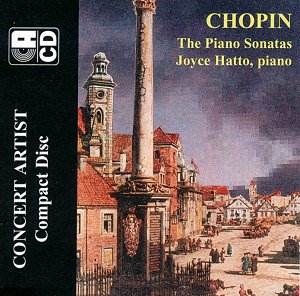This
is volume eight in Joyce Hatto’s recording of the complete works
and it’s been my pleasure to have reviewed a fair few of her discs
on this site. She brings together the three sonatas, works long
in her repertoire and does so with impressive results. In the
early C minor work, a product of Chopin’s youth at the Warsaw
Conservatoire, Hatto imbues the Allegro maestoso with some glorious
right hand delicacy; she brings colour and freshness to the sometimes
undifferentiated material without seeking to elevate the movement
into something it plainly is not. The Scherzo submits to her playfulness
and wit and her control of bracing rhythm – the charming little
waltz emerging elegantly in her hands – and the finale is strong
but controlled, nicely cantilevered and aerated. This is a performance
that treats the sonata justly – and it should additionally be
noted that this is the second time that Hatto has recorded the
sonata., the first in 1958.
Her
Second Sonata recording makes an interesting contrast with that
of, say, Kissin who treats it as a much more febrile instrument
for his pianism. But Hatto is a strong player in her own right
and she has strong views. If she uses rather more pedal than I
would ideally like in the opening of the Grave section of the
opening movement, well she has long ago earned the right so to
do. It does give weight and verticality of sound and an immediacy
of statement. As the movement develops though her playing gets
sharper and crisper, rhythms more incisive and imperious. Some
may find her too prone to suppress the dynamics of the initial
melodic statement but others will admire the effect. In the Scherzo
however she is eloquence itself, full of expressive nuance, tonally
distinguished with more crisp rhythm and digital control. She
brings to the funeral march a particular sensibility; she begins
with intense interior concentration building to a powerful externalisation
of the theme. The middle section is unusually limpid and lyrical
and caressed with rather remarkable delicacy. The finale is fantastically
clean and her pianissimi here are wonderful. This is the polar
opposite of those finger busting "dead" performances
one hears all too often with their almost insolent techniques
paraded to the ruinous detriment of all that has gone before.
The
B minor sonata unfolds with all the clarity, sensitivity and power
one expects from this pianist. Phrasal sagacity is accompanied
by tonal eloquence. She is attentive to balance – of melody, of
hand weight – in the opening movement, whilst she vests some gorgeous
playing on the Scherzo. But she doesn’t exaggerate the sweetness
inherent in it; this is natural musicianship, never taking refuge
in obviousness or in affectation. This is Chopin playing rooted
in an older tradition, one that doesn’t play to the gallery or
affect sentiment in a way both sickly and limiting. So yes those
lines in the Largo are unfolded beautifully; there is limpidity
but a spine of colour and of depth, notably in the left hand.
Above all – and this is another thing I detect in all her playing
– she takes care to characterise each movement. There’s nothing
generic or superficial about this playing. It’s considered, experienced,
understanding of the demands – physical, psychological, expressive
– that the pianist must meet. And so in the finale she brings
huge clarity but also characterises its volatility with assurance.
She brings colour and a profile, as well as the prerequisites
of drive and drama, and they are all very impressive. Those who
have followed Hatto so far in her Chopin series will assuredly
want to follow her here. They will be rewarded.
Jonathan
Woolf
see
also review by Colin
Clarke
MusicWeb
can offer the complete
Concert Artist catalogue
